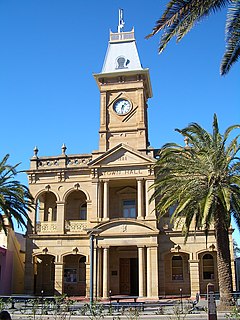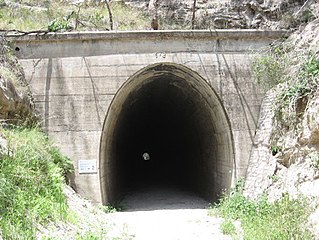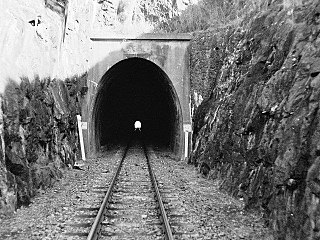
Stanthorpe is a rural town and locality in the Southern Downs Region, Queensland, Australia. In the 2016 census, Stanthorpe had a population of 5,406 people. The area surrounding the town is known as the Granite Belt.

Wallangarra is a town and locality in the Southern Downs Region, Queensland, Australia. It is the third most southerly town in Queensland, 258 kilometres (160 mi) south west of Brisbane. Wallangarra is on the Queensland side of the border and Jennings is on the New South Wales side.

The Granite Belt is an area of the Great Dividing Range in the Darling Downs region of Queensland and the New England region of New South Wales, Australia. The Granite Belt is centered on the town of Stanthorpe. The cool, high country of the granite belt is located on Queensland's southern border. It is the northernmost part of the New England Tablelands.

The Shire of Stanthorpe was a local government area of Queensland, Australia on the Queensland-New South Wales border. It was on the Great Dividing Range and was part of the Granite Belt. Its main industries included fruit and vegetable growing, wineries and tourism, and sheep and cattle grazing.

The Southern Downs Region is a local government area in the Darling Downs region of Queensland, Australia, along the state's boundary with New South Wales. It was created in 2008 from a merger of the Shire of Warwick and the Shire of Stanthorpe.

The Amiens railway line was a branch railway in the Granite Belt region of Queensland, Australia, branching from the Southern Line at Cottonvale between Warwick and Stanthorpe. The Amiens line was the highest in southern Queensland, with the railway reaching an elevation of 946 metres above sea level at Pozieres.
The Maryvale railway line was a branch railway in the Southern Downs region of Queensland, Australia.

The Southern railway line serves the Darling Downs region of Queensland, Australia. The 197-kilometre (122 mi) long line branches from the Western line at Toowoomba, 161 kilometres (100 mi) west of Brisbane, and proceeds south through Warwick and Stanthorpe to the New South Wales/Queensland state border at Wallangarra.

Boolboonda Tunnel is an abandoned heritage-listed railway tunnel at Tunnel Road, Boolboonda, Bundaberg Region, Queensland, Australia. The tunnel is 192 metres (630 ft) in length making it the longest unsupported man-made tunnel in Queensland. Its construction represented an important engineering feat for rail transport in Queensland. It was built from 1881 to 1884 by O'Rourke & McSharry. It is also known as Boolboonda Railway Tunnel and SEQ-6Q 1. It was added to the Queensland Heritage Register on 24 September 1999.

Armidale railway station is a heritage-listed railway station at 240 Brown Street, Armidale, Armidale Regional Council, New South Wales, Australia. It was built from 1882 to 1883 by Edmund Lonsdale and Henry Sheldon Hoddard, and was opened on 3 February 1883 when the line was extended from Uralla. It was the terminus of the line until it was extended to Glen Innes on 19 August 1884. It was added to the New South Wales State Heritage Register on 2 April 1999.

Dalveen is a town and a locality in the Southern Downs Region, Queensland, Australia. It borders New South Wales. In the 2016 census, Dalveen had a population of 335 people.

The Main Line is a railway line in South East Queensland, Australia. It was opened in a series of sections between 1865 and 1867. It commences at Roma St Station in Brisbane and extends west 161 km to Toowoomba. It is the first narrow gauge main line constructed in the world. The section of the line from the end of Murphys Creek railway station to the Ruthven Street overbridge, Harlaxton is listed on the Queensland Heritage Register. The Murphys Creek Railway Complex, the Lockyer Creek Railway Bridge (Lockyer), the Lockyer Creek Railway Bridge and Swansons Rail Bridge are also heritage listed.

Muntapa Tunnel is a heritage-listed tunnel from Narko-Nutgrove Road, Highgrove through to Nutgrove, both in the Toowoomba Region, Queensland, Australia. It was designed by Queensland Railways and built from 1910 to 1913 by Queensland Railways. It was added to the Queensland Heritage Register on 3 May 2007.

Wallangarra railway station is a heritage-listed railway station at Woodlawn Street, Wallangarra, Southern Downs Region, Queensland, Australia. It was built in 1877 along the state border of Queensland and New South Wales It was added to the Queensland Heritage Register on 28 March 2003.

Quart Pot Creek Rail Bridge is a heritage-listed railway bridge at Quart Pot Creek, Stanthorpe, Southern Downs Region, Queensland, Australia. It was built in 1886. It is also known as the Red Bridge. It was added to the Queensland Heritage Register on 21 October 1992.

Cherry Gully Tunnel is a heritage-listed railway tunnel on the Warwick - Stanthorpe Line, Silverwood, Southern Downs Region, Queensland, Australia. It was built from 1878 to 1880 by J & A Overend & Co. It is also known as Gorge Tunnel and Big Tunnel. It was added to the Queensland Heritage Register on 28 July 2000.

Central Hotel is a heritage-listed hotel at 140 High Street, Stanthorpe, Southern Downs Region, Queensland, Australia. It was built from 1908 to c. 1978. It is also known as Quinn's Hotel and Sheahan's Hotel. It was added to the Queensland Heritage Register on 21 October 1992.

Warwick railway station is a heritage-listed railway station on the Southern railway line in Warwick, Southern Downs Region, Queensland, Australia. It was built from c. 1881 to 1910s. It was added to the Queensland Heritage Register on 24 September 1999.

Stanthorpe railway station is located on the Southern line in Queensland, Australia, serving the town of Stanthorpe.

Silverwood is a rural locality in the Southern Downs Region, Queensland, Australia. In the 2016 census, Silverwood had a population of 38 people.





















